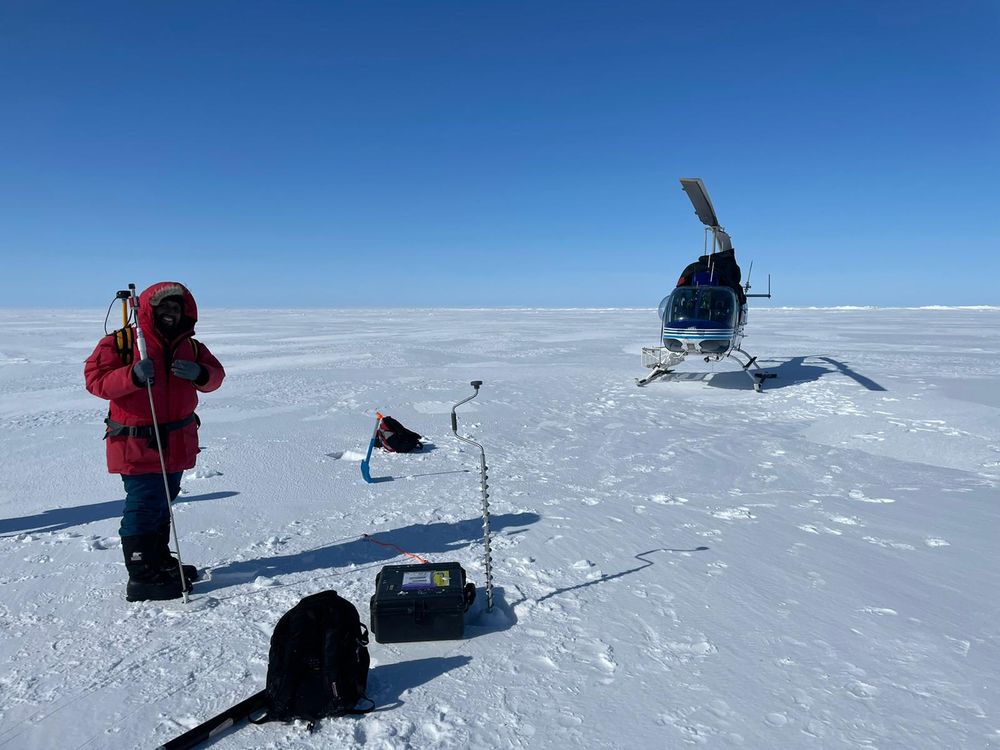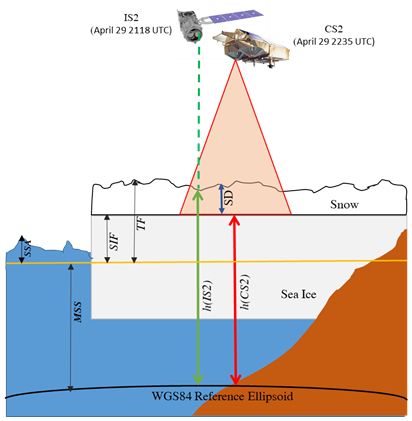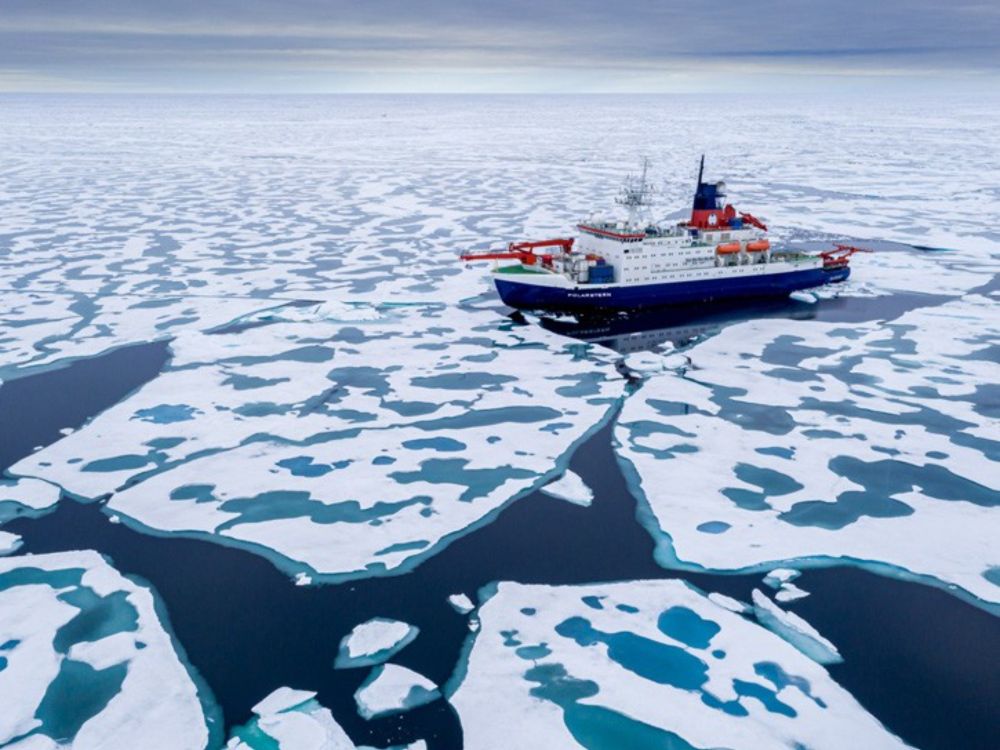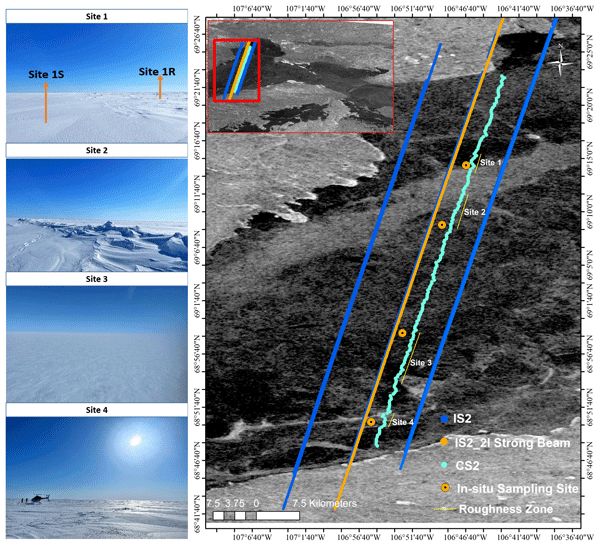I'll be doing an oral talk on "ICESat-2 Arctic Lead Detection Under Partially-Cloudy Conditions Using Deep Learning" at AGU 2025 in New Orleans!
C52A - Remote Sensing of the Cryosphere
Friday, Dec 19, 11:10 - 11:20 am
If you're attending and interested to chat, feel free to reach out!
#AGU25
10.12.2025 04:03 — 👍 3 🔁 0 💬 0 📌 0
Just love watching the Arctic sea ice grow!
07.11.2025 07:22 — 👍 18 🔁 3 💬 0 📌 0

Thrilled to share that I’ve been awarded the Jingli Yang Summer Fellowship at the University of Maryland, College Park!
This fellowship will support my summer research project titled “Improving Near-Shore Lead Detection from ICESat-2 and Sentinel-1 using Deep Learning”❄️🛰️
26.05.2025 05:17 — 👍 2 🔁 0 💬 0 📌 0

Thank you for pushing me consistently, to think, to learn and execute. Everything that I know today is because of you My Guardian Angel, My BOSSS! Thank you for the incredible mentorship. You are the best!!!!
@lifeofpili.bsky.social
11.05.2025 00:56 — 👍 3 🔁 2 💬 0 📌 0
ICESat-2’s Laser Fires 2 Trillionth Shot, Spots Clouds – ICESat-2
Happy 2,000,000,000,000th, ICESat-2! NASA’s Earth-observing laser in orbit passed a milestone on March 9 at 12:51 p.m. EDT — 16:51:00.268 UTC, to be precise — as its laser instrument fired for the 2 trillionth time and measured clouds off the coast of East Antarctica.
blogs.nasa.gov/icesat2/2025...
16.03.2025 00:17 — 👍 0 🔁 0 💬 0 📌 0
https://earth.esa.int/eogateway/missions/cryosat/cryo2ice
9/ You can learn more about the #Cryo2Ice Campaign which realigned #ESA 's #Cryosat2 to have better coincidence to #NASA's #ICESat2 which made this study possible: t.co/F4jKH64ooa
30.01.2025 01:23 — 👍 0 🔁 0 💬 0 📌 0
8/ This is my first published paper out of my Masters at @ceos_um! Thanks to my mentors and colleagues there for all their support!
30.01.2025 01:23 — 👍 0 🔁 0 💬 1 📌 0
7/ Big thanks to my co-authors, field team, and mentors for the support! @JulienneStroeve @melting_sea_ice @jclandy @Vishnu_seaice @dustinisleifson @hoiminglam
30.01.2025 01:23 — 👍 0 🔁 0 💬 1 📌 0
6/ 🤔 Why does this matter? Snow depth on sea ice is correlated with sea ice thickness. Accurate monitoring helps Arctic communities and climate science.
30.01.2025 01:23 — 👍 0 🔁 0 💬 1 📌 0
5/ 🌍 Our method demonstrates that it’s possible to retrieve snow depth in leadless regions, providing critical insights for Arctic monitoring.
30.01.2025 01:23 — 👍 0 🔁 0 💬 1 📌 0

4/ 🌊 We validated our results using in situ measurements near Cambridge Bay, Nunavut. On average, Cryo2Ice snow depths underestimated in situ values by 2 to 4 cm, but the snow depth distributions match well between Cryo2ice and in-situ.
30.01.2025 01:23 — 👍 0 🔁 0 💬 1 📌 0

3/ 🔍 Our study is the first to assess snow depth retrieval using #Cryo2Ice data in a leadless region. Without leads to estimate sea surface height, we developed a method using ellipsoidal height differences between the satellites and accounting for tides.
30.01.2025 01:23 — 👍 0 🔁 0 💬 1 📌 0
2/ ❄️ Snow depth on Arctic sea ice is crucial for understanding ice thickness, ecosystem processes, and supporting human activities. But in leadless regions like the Canadian Arctic, measuring snow depth is particularly challenging.
30.01.2025 01:23 — 👍 0 🔁 0 💬 1 📌 0
Physical Oceanographer focusing on sea ice-ocean interactions. French in Norway. My heart balances between outdoor evasion and a warm sofa.
Mayor-Elect of New York City
Perfil oficial da COP30 no Brasil
Official account of COP30 in Brasil
🗓️ Nov, 2025
📍 Belém, Brasil
#COP30noBrasil
We are a student-led group advancing dialogue on science and technology policy at the University of Maryland, College Park.
A vision for a new economic patriotism. Let’s invent it, make it, & buy it in America. Pro-worker, pro-union, pro-family.
Text me: (650) 999-9610
https://linktr.ee/ro_khanna_town_halls
PolarRES (2021–2025) was a Horizon 2020 project exploring the future climates of the polar regions.
Discover all the resources we produced at: https://polarres.eu/
We are the National Snow and Ice Data Center at the University of Colorado Boulder. We conduct innovative research and provide open data to understand how the frozen parts of Earth affect the rest of the planet and impact society.
We are a collaborative research program dedicated to securing Antarctica's environmental future. Funded by the Australian Research Council as a Special Research Initiative.
I track #Arctic #shipping #LNG #Oil #Russia #sanctions
for arcticinstitute.bsky.social | gcaptain.bsky.social | highnorthnews.bsky.social | Tips: Signal http://bit.ly/malte57 or malte.humpert@proton.me
The purpose of the group is to strengthen the professional collaboration between early career polar scientists.
Follow us on:
Website: https://www.usapecs.org/
Youtube: https://www.youtube.com/@usapecs
LinkedIn: https://www.linkedin.com/company/75859966
Physicist. Climate, sea ice, earth observation @awi.de #Bremen
https://orcid.org/0000-0001-7086-3299
https://det.social/@seaice
The Cryosphere Research Group at DTU Space 🌍❄️ | Geodesy & Earth Observation Department |
Dad, mountaineer, heliophysicist. I lead the PUNCH space mission and direct a team at SwRI. I like science, space, communication, humans, dogs, horses, puns. Lowering barriers and promoting open science are priorities. My personal account; my opinions.
Promouvoir la connaissance des régions #australes et #polaires | Promoting knowledge of #austral and #polar regions #Arctic #Antarctica #TAAF
Compte maintenu par @thalassarche46.bsky.social
Cutting-edge research, news, commentary, and visuals from the Science family of journals. https://www.science.org
Professor of Glaciology at Scripps Polar Center, UC San Diego
https://bsky.app/profile/scrippsocean.bsky.social
Studies Antarctica with satellites
🇦🇶🛰️🧊
Graduate of @UCL & @UTAS
Happy to be safely on Bluesky
❄️❄️❄️
Polar Bears International is the only nonprofit dedicated solely to the conservation of polar bears and the sea ice habitat they depend upon.
Understanding and protecting the planet since 1903.
📍UC San Diego
Entrepreneur
Costplusdrugs.com






